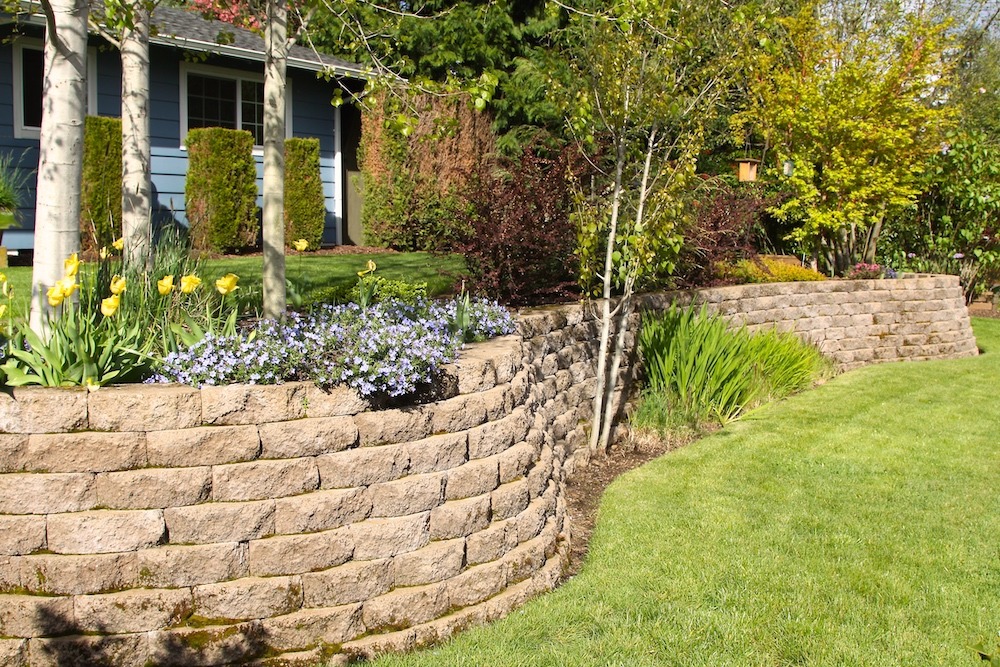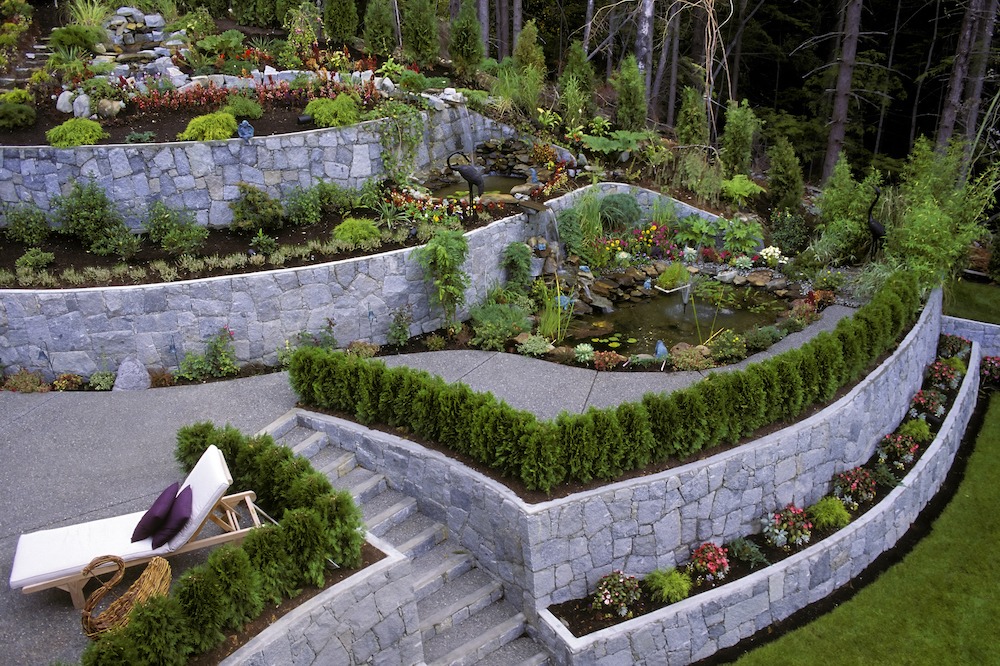Words: Steven Hansen
Photo: laughingmango, davelogan
Retaining walls are essential elements in the built environment. Most are functional, though some are purely decorative. The range of materials is vast, but the segmental block wall is ubiquitous in both residential and commercial applications.
Joe Raboine, Director of Belgard Residential Hardscapes, talked with MASONRY about retaining walls and key points in their design and construction, in addition to the promising opportunities for contractors.
“In major cities, you’re now seeing many infill development sites; those are typically sites nobody wanted to develop before because they were difficult with slopes,” Raboine said, “So you’re going to see more and more walls going up in these spaces just to make them more usable. There is definitely an opportunity.”
The segmental retaining wall is popular for many reasons, including the variety of sizes and face treatments available. Some are smooth-faced, and some are split face or molded, lending a rougher, more natural look. They’re made in a variety of sizes and are usually dry-laid. Some use pins to anchor the layers, and some use a formed lip with a setback. Both work well.
According to Raboine, the walls are designed to move and flex with freeze-thaw cycles. They’re backfilled with clean stone and usually have a drainage tile. “The water passing through the hill will hit that gravel, it will travel down to the tile, and then it’ll be dispersed out,” he said.
Design is flexible and engineering is crucial
The design of the wall will depend on the site. Cut walls require cutting into a hillside, while fill walls extend the built area, as with a terrace. They’re treated differently from an engineering perspective, but both have the weight of the soil behind putting pressure on the wall.
“Each retaining wall project is treated uniquely,” Raboine said. “You have to look at several factors: is it a cut wall or a fill wall? How high is it, and then how much pressure is being exerted on it? If you have a parking lot built on top, for example, it’s filled in, and there’s a lot of weight on there.”
Flexibility with design is one reason segmental walls are so popular, but each wall is unique. If a site requires an 8-foot high wall, it can be designed as two 4-foot walls, curving or straight, and so on. In addition to simply retaining soil, walls can be part of an outdoor living space, incorporating built-in seating, firepit, and planting spaces, for example. “There are many creative ways to change the look and feel of a wall and make it an asset to that space. It doesn’t have just to be a functional piece,” Raboine said.
Other design considerations include necessities like stairs, which can be tricky if they turn and/or incorporate landings. Lighting is also popular and functional. “We’ve got under-capped lights that can create a wash effect on the wall that can make these look incredible at night, so that’s a consideration,” he said.
Segmental walls can be built quite high, and require geogrid and engineering once they reach 3-4 feet in height, according to Raboine. “We do a lot of it, we can do it in every state, and typically, they’re pretty standard engineering documents,” he said.
Walls over that height are treated as unique projects that are definitely non-standard. “There’s a lot more involved with them,” he added, especially engineering the use of geogrid, which is a catchall term for a woven grid product made from plastics and polymers that is installed behind the wall in multiple layers separated by layers of backfill.
“It looks like a snow fence. A lot of people are familiar with snow fences, but you cannot use snow fences. Some contractors try,” Raboine noted.
“You may have a layer every two or three courses that have geogrid that goes back into the hill anywhere from 6–20 feet, and the further back it goes, the more excavation you’ve got,” he said.

Proper construction techniques required
Segmental walls are simple to build, Raboine said, but following the engineering documents is mandatory. “The last thing we want is our contractors installing these improperly. I mean, not only is it bad if there’s an issue, it can be dangerous,” he noted. “Some of these walls are very tall, and if they’re not engineered correctly, you could do some severe damage or even life-threatening injury to someone.”
Starting with a properly compacted base and then getting the first course perfectly level enables the rest of the build to go smoothly. Then stacking a course or two, backfilling, and compacting according to the engineering documents. “You can’t just stack the wall straight up,” Raboine said. “You’ve got a stack, a couple of courses, add backfill, compact the fill behind it, put the geogrid in. The challenge is learning the proper sequence of each step and what is necessary at each of those steps.”
“It’s not by any means rocket science. I mean, it’s pretty simple, you’re moving materials,” Raboine noted, but following the engineering is the key. “Whatever they tell you to do, just follow it to the T, and you’ll be covered. And from a liability aspect, you will also be covered because you followed what that engineer laid out, so essentially follow directions, and you’ll be okay.
Other retaining wall types
Poured walls
Though popular in commercial construction, the cost of poured-concrete walls can be a turnoff to homeowners. According to Raboine, they require more extensive footings and drainage can be an issue. “You have to be more concerned about drainage because no water will pass through the poured wall, so you have more engineering on the backside,” he said.
Stone walls
The variety of stone available for use in walls is excellent, and stone walls tend to be a more custom and high-budget project. Ledge stone, often limestone, is popular, and can be found in coffin-sized chunks and larger, meaning machines are required for construction. Granite boulders are beautiful and durable as well, and all dry stacked stone walls require a stonemason with plenty of expertise in both construction and the aesthetics of the building.
“Those are a little more difficult to engineer because you don’t have a consistency like the type of stone thickness, weight, all of that varies per project,” Raboine said. “There’s an ample opportunity for it; it’s just something you need to want [to know how to do.] You have to love building those as a passion,” he added.
For mason contractors interested in learning more about retaining wall building, Raboine offered to help. “We’ve got ongoing classes, we’ve got videos and tons of literature that we can provide. We have a national team of engineers and experts that can assist with such a huge opportunity in this space. There’ll always be a need for retaining walls, and the technology and products are continually evolving.”
